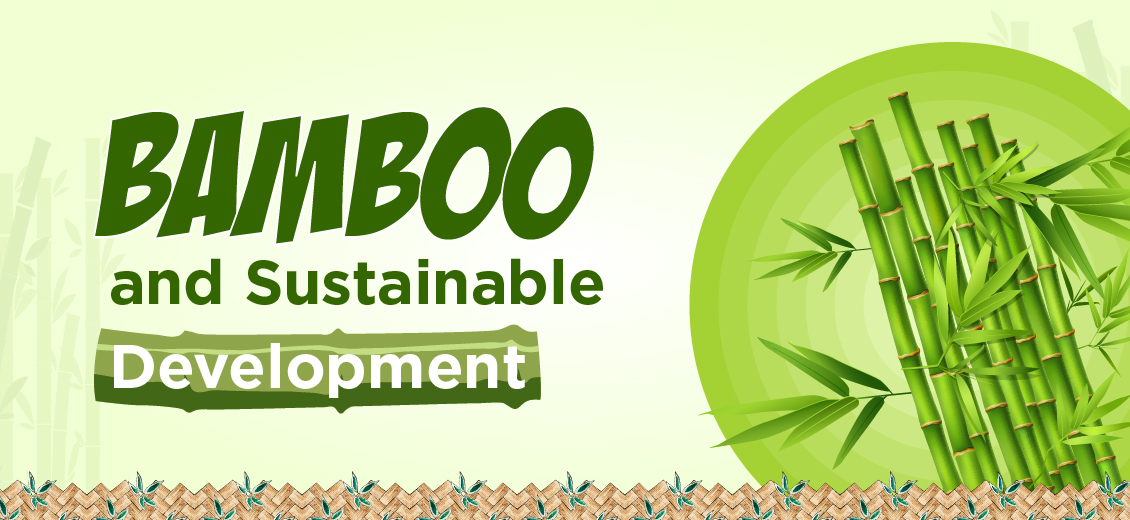Bamboo and Sustainable Development
Blogs Home
- 19 Sep 2023

Bamboo has the unique ability to withstand harsh conditions that are typically intolerable for most other plants. In fact, it holds the distinction of being the initial plant to regenerate and display green growth following the atomic explosion in Hiroshima in 1945. A bamboo grove produces 35% more oxygen than a comparable group of trees. As a result, growing bamboo is a fantastic method for reducing carbon footprint and contributing to the fight against global warming. Wood can be successfully replaced by bamboo. The Bamboos, which belong to the Bambusoidaea family, encompass 1,439 distinct species distributed across 116 genera. They represent a single subfamily within the Poaceae family, comprising the only subfamily that has thrived and diversified primarily in forested environments.
World Bamboo Day is celebrated on September 18th every year to raise awareness about the importance of bamboo and its many uses. Bamboo is a fast-growing, sustainable resource that can be used to produce a wide range of products, including building materials, textiles, furniture, and food.
Bamboo's Green Potential: A Natural Ally Against Climate Change
In the fight against climate change, bamboo emerges as a vital asset, especially for rural communities in the developing world. The International Bamboo and Rattan Organisation (INBAR) highlights five key roles bamboo plays in climate change mitigation and adaptation:
- Carbon Sequestration: Bamboo's rapid growth captures carbon efficiently, making it a potent carbon sink. Bamboo products further lock in carbon, reducing overall carbon footprints.
- Reducing Fossil Fuel Dependence: Bamboo offers renewable biomass energy, reducing reliance on fossil fuels. It provides sustainable bioenergy for cooking, electricity, and heating, alleviating deforestation pressures.
- Adaptation: Bamboo's flexibility in harvesting allows farmers to adapt to changing climate conditions, providing a year-round income source.
- Restoration: Bamboo thrives in challenging environments, aiding land restoration efforts by preventing erosion and restoring degraded lands.
- Livelihoods: With diverse applications, bamboo presents economic opportunities for communities, particularly as other resources strain due to climate change.
While bamboo alone won't solve climate change, its proper utilisation offers practical solutions for both mitigation and adaptation, combating poverty and bolstering sustainable economic development. INBAR plays a pivotal role in promoting bamboo's environmentally sustainable potential.
Bamboo in Agriculture and Livelihoods
Bamboo plays a crucial role in agroforestry systems and has the potential to enhance soil health and water retention in several ways. It has an extensive root system that helps bind soil particles together, reducing soil erosion. This is especially important in agroforestry systems where erosion control is necessary to protect valuable topsoil. This is particularly valuable in regions with erratic rainfall patterns or during dry spells when water retention is critical for plant growth. Bamboo leaves and stems contain nutrients that can be recycled back into the soil when they decompose. This nutrient cycling can enhance soil fertility and improve the overall health of the agroforestry system. Its leaves and fallen stems can be used as mulch, which helps conserve soil moisture by reducing evaporation, moderating soil temperatures, and suppressing weed growth. Bamboo can be strategically planted alongside other crops in agroforestry systems, providing support for climbing plants like beans and creating microhabitats for beneficial insects.
Bamboo as a Construction Material
The raw material also has the distinct advantage of being one of the greenest building materials currently on the market. Its growth conditions are where its sustainability credentials begin. Pesticides and fertilizers that harm the environment are not necessary because bamboo is so robust. The bamboo plant is not harmed when it is picked. Instead, a portion of the stalk is left in the forest, igniting the plant's root system and causing it to sprout again. In addition, bamboo has a lower carbon footprint than building materials like steel, concrete, and even wood. Companies have been using the plant as a substitute for wood. Today, everything from flooring to railway sleepers and manhole covers is made from engineered bamboo, which has undergone special processing to produce a consistent, straight-edged material.
Bamboo and Biodiversity Conservation
Bamboo has recently drawn attention for its potential to remove significant amounts of carbon dioxide from the atmosphere, which would help keep global warming below 1.5C, along with tree planting. Bamboo is a resource that regenerates quickly and can provide more biomass than both wild and artificial forests. Once fully developed, bamboo stakes can be picked carefully each year and utilised to create a variety of long-lasting goods that trap carbon for the rest of their useful lives. Because of its large production, bamboo is a significant natural method of global warming mitigation and a surprisingly effective carbon sink.
Bamboo is a significant source of food and shelter for a wide variety of creatures, including some of the most endangered species in the world, with over 1,600 identified species and more than 30 million hectares spread out over the globe. Although the giant panda, which consumes up to 26 to 84 pounds of bamboo per day, is well-known for doing so, it's not the only animal that depends on this wonder plant for survival. Bamboo is consumed by a wide variety of species, including mountain gorillas, Indian elephants, spectacled bears from South America, red pandas, and many more.
Bamboo Farming and Management
Bamboo is an evergreen, permanent, and flowering plant. It is one of the crops used for commercial purposes in India and is also known as "poor man's timber." In hot to warm temperate climates, the bamboo plantation thrives. However, it must be kept in mind that during the summer, temperatures below 15 degrees Celsius are not necessary. Additionally, well-drained sandy to clay soil with a pH range of 4.5 to 6.0 is needed for bamboo plantations. The Barack Valley region in India has the greatest soil and ideal climate conditions, making it the best place to grow bamboo. Typically, culm cuttings or rhizomes are used to multiply bamboo plants. However, they can also be multiplied with the use of seeds, which are extremely rare. Bamboo seedlings are essentially nurtured on nursery beds before being allowed to grow in poly pots for around a year. The seedling is later moved into the primary field.
Bamboo-based Industries and Economic Growth
Bamboo offers a powerful method for reducing rural poverty and securing livelihoods since it can serve as the foundation for a growing small and medium enterprise sector. There are 1,500 recorded uses for bamboo, including food, a wood substitute, building and construction materials, a source of handicrafts, pulp, and paper. The two sectors that employ bamboo resources most extensively are the pulp and paper industry and the bamboo crafts business. According to a data, the utilisation of bamboo across various sectors within the nation demonstrates that 24% of bamboo is employed in scaffolding, 20% in the production of pulp and paper, 19% in crafting handicrafts, and 15% in various other miscellaneous applications. It, also known as "green gold ", for its many uses, has the potential to give rural residents financial stability. It contributes significantly to India's economy and supports the livelihoods of millions of people.
Bamboo and Indigenous Communities
As per the Forest Survey of India from 2011, over half of all bamboo species are concentrated in the eastern region of India, encompassing states such as Arunachal Pradesh, Assam, Manipur, Meghalaya, Mizoram, Nagaland, Sikkim, Tripura, and West Bengal. It is a major cultural practice in the area, with bamboo being used to construct fishing nets, baskets, jars, vases, and other items. Compared to the physical area occupied by other states, Mizoram has the biggest bamboo cover in India; over 50 % of Mizoram's territory is covered in bamboo forests.
Due to its use in religious rituals, art, and music, bamboo is an essential component of our way of life and culture. Consequently, it is a mysterious plant that permeates our everyday existence. "Bamboo for living and living with bamboo" is still the norm for indigenous people and people who live in the jungle. This provides the rural poor with a great starting point for boosting employment, generating income, and enhancing their nutritional status.
Government Policies and Initiatives
Asia is home to nearly 80% of the world's bamboo forests, which cover 19.8 million hectares in India, China, and Myanmar. Only China produces more bamboo than India, which has one of the world's largest bamboo resources. The Government of India's Ministry of Agriculture and Farmers Welfare estimates that 3.23 million tonnes of bamboo are produced there each year. While being the second-largest producer of bamboo in the world, India only accounts for 4% of worldwide trade and commerce in the sector. It has enormous potential to increase the area where bamboo is grown.
Promoting bamboo cultivation, processing, and trade is a multifaceted endeavour that can have numerous economic, environmental, and social benefits. Governments around the world have recognised the potential of bamboo and have implemented various policies and initiatives to support its growth. The government of India has also approved the restructured National Bamboo Mission (NBM) in April 2018. It is a unique endeavour centred on the holistic advancement of the bamboo sector, employing an interdisciplinary approach that spans various sectors. In alignment with the honorable Prime Minister's vision of doubling farmers' income and the "Har Medh Par Ped" (a tree on every farm) initiative, it will provide additional sources of income and livelihood, particularly in situations where crops may be adversely affected by extreme events.
Research and Technological Advancements
The biomass derived from bamboo has a lot of potential as a source of raw materials for the manufacture of biofuels and bioenergy. Excellent fuel properties in bamboo allow it to be transformed into solid, liquid, and gaseous biofuels. The researchers were able to turn bamboo into basic sugars, which can subsequently be fermented to produce ethanol.
While bamboo has long been a staple of Asian diets, Western countries are now starting to recognise its potential as a nutritious, and healthy meal.
Bamboo leaves have traditionally been utilised for their astringent properties, as well as for creating ophthalmic solutions, addressing menstrual issues, promoting wound healing, and acting as a fever reducer. These leaves are also incorporated into Ayurvedic medicine for managing paralysis-related ailments and addressing various inflammatory disorders.
Challenges and Future Prospects
The irregular and limited supply of bamboo for commercial usage has been the largest barrier to the growth of a sector based on bamboo. Due to this irregular and limited supply, India's paper and pulp industry, which has been employing bamboo for more than 50 years, has continuously innovated to use less of the material in its production. There is virtually little left behind after the paper mills have consumed it all. All Indian states follow this pattern. The clear cause for this irregular and insufficient supply is India's current regulatory system.
Government policies and initiatives to promote bamboo cultivation, processing, and trade can contribute to economic development, environmental sustainability, and social empowerment. By creating an enabling environment, providing financial support, and fostering innovation, governments can harness the full potential of bamboo as a versatile and sustainable resource.
Sources:
- https://www.ncbi.nlm.nih.gov/pmc/articles/PMC4910292/
- https://www.ifad.org/en/web/latest/-/story/five-ways-bamboo-can-fight-climate-change4
- https://lewisbamboo.com/pages/interesting-facts-about-bamboo#:~:text=Bamboo%20is%20the%20fastest%20growing,an%20equivalent%20stand%20of%20trees.
- https://www.worldwildlife.org/stories/what-do-pandas-eat-and-other-giant-panda-facts
- https://chinadialogue.net/en/climate/fighting-climate-change-with-bamboo/#:~:text=Once%20mature%2C%20bamboo%20poles%20can,approach%20to%20mitigating%20global%20warming.
- https://sarkarifocus.com/bamboo-industry-in-india/
- https://nbm.nic.in/
- https://krishijagran.com/agripedia/a-complete-guide-to-bamboo-cultivation/
- https://www.swst.org/wp/meetings/AM12/pdfs/papers/PS-20.pdf
Arifa Nadeem

Arifa Nadeem is from Jhansi, UP. She has qualified for UGC NET in Tourism Administration & Management and is currently pursuing her Ph.D. in Tourism from Bundelkhand University, Jhansi.
Blogs Home



